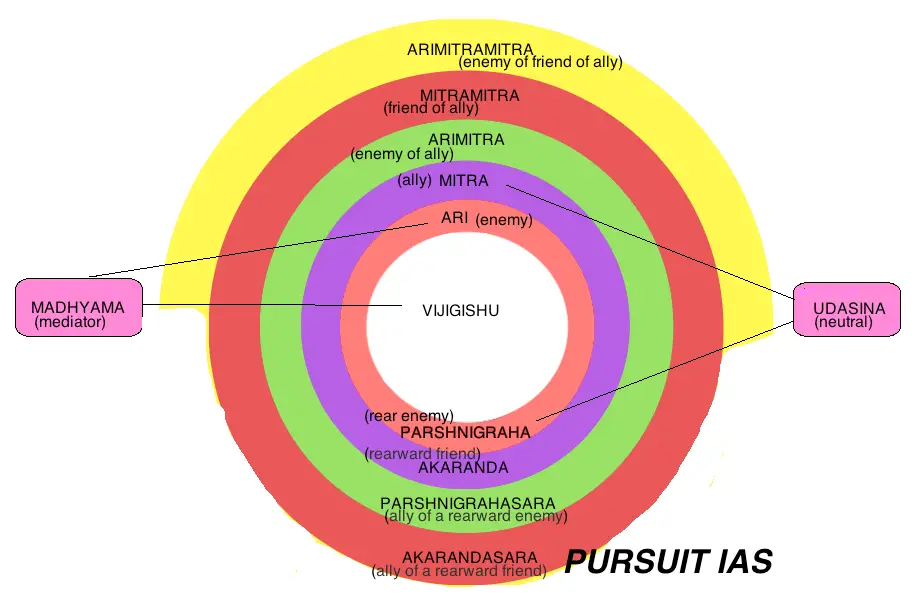The Mandala Theory : What Do You Need To Know?

The basic idea of the Mandala Theory is ‘ If your neighbour is your natural enemy then your neighbour’s neighbour is your natural ally.’ This theory was put forth by the great Chanakya. The Mandala Theory, also known as the Rajamandala is clearly explained in detail in his book ‘The Arthasashtra’.
Chanakya, also known as Kauṭilya or Vishnugupta was an Indian teacher, philosopher, economist, jurist and royal advisor. He is a well-known pioneer in the field of political science and economics in India. Chanakya was the mastermind and the pillar behind the rise of the Mauryan emperor Chandragupta. He has also played a huge role in the establishment of the Maurya Empire.
The Mandala Theory
The theory of Mandala is based on the geographical assumption that the immediate neighbor state of a given state is most likely to be an enemy and a state next to the immediate neighbor is likely to be one’s friend. Thus, after a friendly state comes an unfriendly state (friend of the enemy state) and next to that a friendly state (friend of a friendly state) and so on. Thus, this form circles of friends and foes with the central point being the King and his State.
According to Chanakya, the states which are one’s neighbours and are also neighbours of one’s enemies are neutral and should always be treated with respect.
According to him, this circle is dynamic and the King should strive to expand his central position and reduce the power of the other kings in his vicinity. As per the theory it is advised to build alliances with states which are two degrees away from the center to create a balance of power.

Moral principles or obligations have little or no force in altering the actions among nations because every nation acts to maximize power and self-interest. Even if it is good to have an ally, the alliance should last long only as long as both the parties’ self-interests are served.
War and peace are both considered merely from the POV of profit. According to him, there is some self-interest behind every friendship and there is no friendship without self-interests. This is the bitter truth because nations always act according to their political, economic and military self-interest. Even during times of peace, there are possibilities of wars, allies turning into enemies, and even enemies turning into allies.

“A King should not hesitate to break any friendship or alliances that are later found to be disadvantageous.” – Chanakya
In the world of international politics, it is obvious that the nations are going to interact with each other through dissension and force. There will always be conflicts in international relations where the strongest will always dominate the weaker ones.
Chanakya advocated six-fold policy to interact with the neighbors, which included co-existence, neutrality, alliance, double policy, march, and war. He advised the king to resort to five tactics in order to follow the six-fold policy. The five tactics are conciliation, gift, and bribery, dissension, deceit and pretence, open attack or war.
Six Methods of Foreign Policy
As per the Mandala theory, states participate in diplomacy and war using the six methods of foreign policy which are :
- Sandhi:- The peace treaties should be made with specific conditions to promote welfare and development. They should also strengthen alliances or use the period as one arm of dual policy. According to Chanakya, one can enter into a treaty with one’s enemy and it could be broken when one grows strong. The interests of one’s state should always be held supreme.
- Vigraha:- The policy of hostility is recommended to be followed by the stronger state. The hostilities can be conducted as open, secret, undeclared or clandestine attacks. Diplomatic wars too are justified on all levels.
- Asana:- The policy of remaining neutral is highly recommended when both states are equal.
- Yana:- Very careful consideration is to be made before taking the important decision on wars. Since the preparation for war and the long march entailed heavy expenditure and prolonged absence from the capital.
- Samsraya:- The policy of seeking protection of a stronger king/authority can be practised by entering into alliances or by signing a treaty.
- Dvaidhibhava:- This is the policy of seeking peace with one king/authority in order to pursue hostilities with another.
Keeping in mind the six methods of foreign policy, we can find the relevance of Mandala Theory in international relations and geopolitics even today.
Thus, we can estimate the sheer brilliance and understanding Chanakya had on international relations and economics even during those days. The ‘Arthasashtra’ is indeed a masterpiece by him which explains in detail the political strategies and diplomatic tactics adopted by him.
Read also – Every One Must Read These Famous Quotes By Legendary Chanakya



